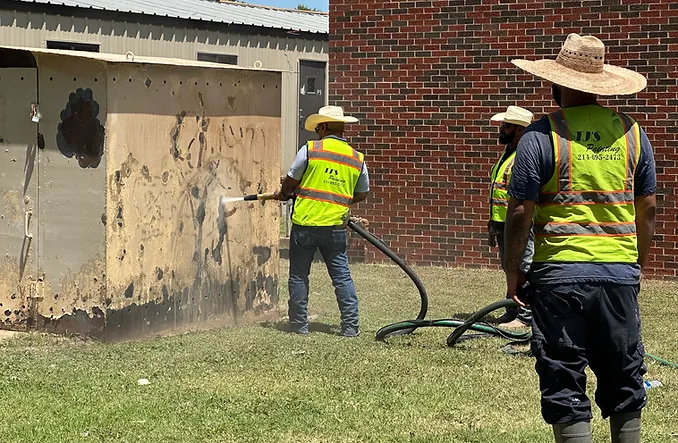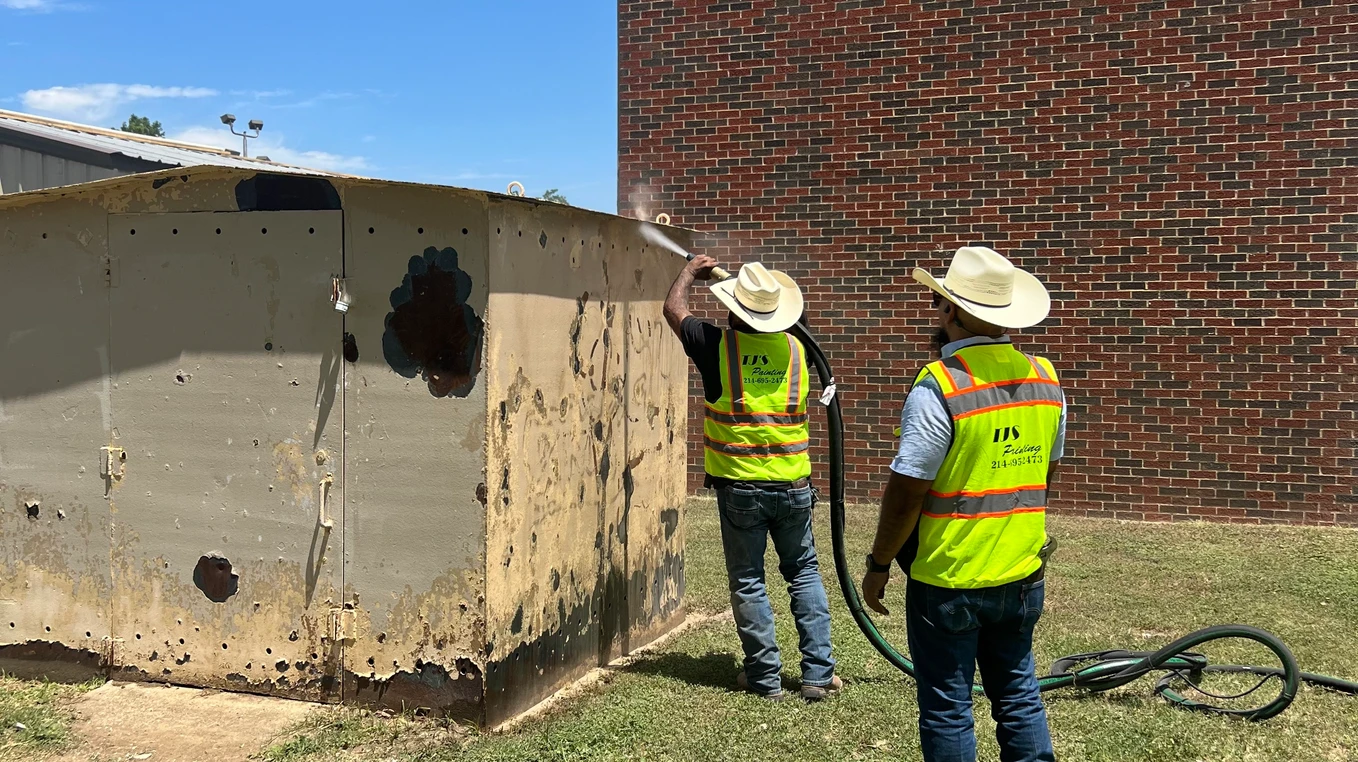Discover the Unmatched Power of Sand Blast: Eliminate Dirt, Rust, Paint, and Corrosion in Seconds!
Are you tired of seeing dirt, rust, and paint ruining the appeal of your valuable machinery or structures? What if we told you that there is a powerful solution that can eliminate these stubborn substances within seconds, leaving your items looking new and freshly polished? Yes, you read that right! The unmatched power of sand blast has taken the industrial world by storm and for all the right reasons. This innovative method of abrasive cleaning is highly effective in eliminating dirt, rust, paint, corrosion and other forms of stubborn buildup. Keep reading to discover more about how this powerful technology works and why it is a must-try for anyone who values precision and efficiency in cleaning.
What is Sand Blasting and How Does it Work
Sandblasting is a powerful method that is commonly used across industries to clean, polish, and surface finish materials. The process involves firing a high-velocity stream of abrasive material, such as silica sand, onto the surface of the material, which helps to remove unwanted impurities, rust, and other contaminants, leaving behind a smooth, polished surface.
The abrasive material used in sandblasting can vary depending on the intended outcome of the process. For example, sandblasting with soft materials such as baking soda or walnut shells is commonly used to clean delicate materials such as glass, while harder materials such as aluminum oxide and garnet are used to remove heavy rust or paint from metal surfaces.
Overall, sandblasting is an effective and cost-efficient method to remove surface contaminants, prepare surfaces for additional coating or treatment, and restore old, worn-out surfaces. It is a versatile technique that can be adjusted to meet the specific requirements of different materials and surfaces, making it an essential tool for many industries, from automotive to construction to manufacturing.

Benefits of Using Sand Blasting for Cleaning and Restoration
If you are still not convinced about the power of sandblasting, here are some key benefits of sand blasing that will make you rethink your traditional cleaning methods:
- Quick and Efficient: Sandblasting can remove years of stubborn dirt, rust, paint or corrosion within seconds. This makes it a highly efficient method for both small-scale and large-scale cleaning needs.
- Precision Cleaning: The high-velocity abrasive material used in sandblasting ensures that every nook and cranny is reached and cleaned, leaving behind a perfectly polished surface.
- Non-Toxic: Unlike chemical cleaning agents, sandblasting uses natural materials such as sand or baking soda, making it an environmentally friendly option for cleaning and restoration.
- Versatility: As mentioned earlier, the abrasive material used in sandblasting can be adjusted to meet different cleaning needs, making it a versatile method for various industries.
- Cost-Effective: By eliminating the need for expensive and often toxic chemical cleaning agents, sandblasting helps to reduce costs while still providing high-quality results.
Sandblasting is an incredibly powerful method that offers unmatched precision, efficiency and versatility in cleaning and restoration. From removing heavy rust to restoring delicate surfaces, this technique has proven time and again to be the go-to solution for many industries.
Different Types of Materials that Can Be Cleaned with Sand Blasting
As mentioned earlier, sand blasting service is a versatile method that can be used on various materials to remove contaminants and restore surfaces. Some of the most common materials that can benefit from sandblasting include:
- Metal Surfaces: Sandblasting is perfect for removing rust, paint and other impurities from metal surfaces such as steel, iron, aluminum, etc.
- Concrete: Sandblasting can help to remove stubborn stains, dirt, and grime from concrete surfaces, making it a popular method for cleaning sidewalks, driveways and other outdoor spaces.
- Wood: Sandblasting can be used to remove old paint or varnish from wooden surfaces, helping to restore their natural beauty.
- Glass: Delicate glass surfaces can also benefit from sandblasting, as it can help to remove dirt and stains without causing any damage.
Sandblasting is a powerful cleaning method that offers unmatched precision, efficiency and versatility. Whether you need to remove rust, paint, or other contaminants from metal surfaces or restore delicate materials such as glass, sandblasting is the way to go.
Safety Considerations to Keep in Mind When Using Sand Blasting
Sandblasting is an effective way to clean and prepare surfaces for painting or coating. However, it is important to take safety considerations seriously when using this technique. One of the most significant risks associated with sandblasting is exposure to airborne particles, which can cause respiratory problems and lung damage. To prevent this, it is essential to wear a respirator that filters out harmful particles and to work in a well-ventilated area.
Another safety consideration to keep in mind when using sandblasting is the risk of eye injury. Sand particles propelled at high speeds can easily damage the eyes if proper eye protection is not worn. It is recommended to wear safety goggles that provide adequate coverage and are designed to withstand impact. Additionally, protective clothing including gloves and work pants should be worn to prevent skin contact with the abrasive material.
It is also important to consider the noise level when sandblasting. The loud noise generated by the equipment can lead to hearing damage if the appropriate ear protection is not worn. Ear muffs or ear plugs with a high enough noise reduction rating are recommended to prevent hearing loss. By adopting these safety considerations, the risks associated with sandblasting can be significantly reduced, ensuring a safer and more productive work environment.

Tips for Choosing the Best SandBlaster for Your Project
Choosing the right sandblaster for your project is crucial to ensure efficient and effective results. Here are some tips to keep in mind when selecting sand-blasting equipment:
Consider the type of material you will be working with. Different materials may require different abrasive materials and pressure levels, so it’s important to choose a sandblaster that can handle your specific needs.
- Determine the size and scope of your project: Sand blasters come in various sizes, from small handheld units to large industrial machines. Consider the size and scope of your project to determine the right equipment for you.
- Check for portability and ease of use: If you need to move around frequently or work in hard-to-reach areas, consider a portable and easy-to-use sandblaster.
- Research the different types of sandblasting techniques: There are various types of sandblasting, such as wet blasting and dry blasting, each with its own advantages and limitations. Do your research to find the best technique for your project.
- Consider safety features: Look for sandblasters that come with safety features such as built-in air filters, pressure relief valves, and adjustable nozzles to ensure safe and efficient operation.
By considering these factors, you can choose the best sandblaster for your project and achieve optimal results.
Tips and Tricks for Safe, Easy Sand Blasting at Home
While sandblasting may seem like a daunting task, it can be done safely and easily at home with proper equipment and precautions. Here are some tips and tricks for safe, easy sandblasting:
- Choose the right location: Find a well-ventilated outdoor area that is away from other people and objects to set up your sandblaster.
- Wear protective gear: As mentioned earlier, it is essential to wear protective gear such as a respirator, safety goggles, and protective clothing when sandblasting.
- Prepare the surface: Make sure the surface you will be working on is clean and free of any loose debris or materials that could interfere with the sandblasting process.
- Test your equipment: Before starting your project, test your equipment on a small area to ensure it is working properly and that you are comfortable with its operation.
- Use the right abrasive material and pressure level: Using the wrong abrasive material or pressure level can damage your surface, so be sure to choose the appropriate settings for your specific project.
- Work in small sections: Sandblasting works best when done in smaller, controlled sections. This allows for more precise and thorough cleaning.
- Clean up properly: After you have completed your sandblasting project, make sure to clean up any debris or leftover abrasive material to prevent potential hazards.
Following these tips and tricks can help you perform safe and effective sandblasting at home, giving you the satisfaction of completing a DIY project while also saving time and money.
Sandblasting is a versatile and powerful cleaning method that can be used on various surfaces and materials. However, it is important to prioritize safety when using this technique to prevent potential hazards. By following the tips and considerations outlined in this guide, you can safely and effectively use sandblasting for your projects at home or in a professional setting. Remember to always wear protective gear, choose the right equipment, and properly prepare and clean up your work area to ensure optimal results. So next time you have a project that requires surface preparation or restoration, consider using sandblasting for an efficient and effective solution. Keep in mind the safety considerations and tips mentioned above to ensure a successful and safe experience. With proper precautions, sandblasting can be a valuable tool to achieve your desired results. Happy blasting!

